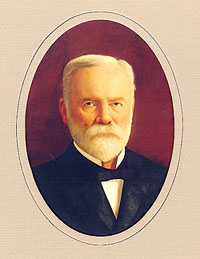- S. W. T. Lanham
Infobox Governor
name = Samuel Willis Tucker Lanham
order = 23rd
office = Governor of Texas
term_start = 1903
term_end = 1907
lieutenant =
predecessor =Joseph D. Sayers
successor =Thomas Mitchell Campbell
birth_date =July 4 ,1846
birth_place =South Carolina
death_date =July 19 ,1908
death_place =Texas
party = Democratic
spouse =
profession = politician, lawyer
religion =
portrait = in the Texas Capitol BuildingSamuel Willis Tucker Lanham (
July 4 ,1846 –July 19 ,1908 ), wasGovernor of Texas fromJanuary 20 1903 toJanuary 15 1907 . He was a member of the Democratic Party. Prior to winning election as Governor, he served two periods in the U.S. House of Representatives. He served five terms from the 11th District (which covered a vast area of West Texas) then ran for governor, losing in his first attempt. When he returned to Congress, it was in the Eighth District, where he served 4 terms.Early years
Samuel Willis Tucker Lanham was born July, 1846 in
South Carolina to James Madison and Louisa de Aubrey (Tucker) Lanham in Spartanburg District (now County), South Carolina, and named for his maternal grandfather, Samuel Willis Tucker. When the Civil War began, Lanham volunteered for theConfederate States Army , despite the fact that he was only fifteen years old. He fought primarily inVirginia , was wounded at theBattle of Spotsylvania Court House Handbook of Texas|name=S. W. T. Lanham|id=LL/fla34] , and after hostilities ended he married. He and his wife settled inWeatherford, Texas , where he worked and studied law.Hendrickson (1995), p. 140.]Shortly after he was admitted to the bar in 1869, Lanham was appointed district attorney. His most famous case was the prosecution of Satanta and Big Tree,
Kiowa chiefs who had led theWarren Wagon Train Raid in 1871.In 1892, Lanham was elected to Congress for the 11th district, where he served for a decade. He ran for the governorship in 1894, losing in the primary to
Charles A. Culberson , but then returned to Congress for six more years, representing the 8th district.Governor
Lanham was elected
Governor of Texas in 1902, taking office in January 1903. He was the last Confederate veteran to serve as governor of Texas. During his administration, many safety regulations were passed. In his first year in office, theTexas legislature passed laws limiting the number of hours a railroad employee could work and regulated child labor.Hendrickson (1995), p. 142.]The
Texas Constitution prohibited a state banking system, and in 1904 voters approved a constitutional amendment all revoke that clause. The following year the legislature passed a bill creating the state insurance and banking commission, and Lanham appointed Thomas B. Love as its first director. Over the next five years, over 500 banks were created.Lanham took the lead in tax reform in 1905. Under the existing Texas system, the bulk of the state's income came from a general property tax. This did not provide the amount of revenue the state wanted to spend, and, at Lanham's request, the legislature began taxing the gross receipts of express companies and pipelines. The legislature also raised taxes on intangible assets of the railroads and other industries.
The legislature also took efforts to reform election laws during Lanham's term. Before he took office, there was not a set procedure for nominating candidates for public office. This led to a great deal of fraud and many shenanigans meant to keep people from voting. The legislature passed two election reform laws during Lanham's administration, both named after their author, Judge Alexander W. Terrell. The first law, passed in 1903, allowed political parties to nominate candidates by either a convention or a primary election. The second law, in 1905, established voter qualifications, required candidates to file itemized expense statement, required primary elections for major parties (at this time, only the Democratic party was considered a major party in Texas), and set a uniform date for primaries.
Near the end of his second term, a large political scandal erupted, Before he took office, the state had filed a lawsuit against
Standard Oil Company and their Texas subsidiary, the Waters-Pierce Oil Company. Waters-Pierce's license to operate was revoked, an action upheld by theU.S. Supreme Court in 1900. Partially at the urging ofU.S. Senator Joseph Weldon Bailey , Waters-Pierce received a new license to operate under GovernorJoseph D. Sayers . Although they claimed to have severed all ties with Standard Oil, Texas filed suit again in 1905 on the discovery that Standard Oil still owned most of the stock in the other company. In the trial, Bailey's influence was revealed, as well as the fact that Bailey had been on the Waters-Pierce payroll at the time. Although Lanham and his administration was not accused of any wrongdoing, the controversy over Bailey's ethics was extremely large.Hendrickson (1995), p. 143.]Lanham did not enjoy his time as governor, often wishing that he had remained in Congress. He said that "'office seekers, pardon seekers, and concession seekers overwhelmed me. They broke my health'".Hendrickson (1995), p. 144.]
After leaving office, Lanham retired to Weatherford, where he died on
July 19 ,1908 .Other
Samuel W.T. Lanham was a
Freemason . His masonic membership was of [http://www.grandlodgeoftexas.org/l_locate.php?act=view&id=275 Phoenix Lodge #275 of the Grand Lodge of Texas] in Weatherford, Texas.Lanham's son Frederick was also a member of the House of Representatives, serving 14 terms from 1919-1947. Grandson
Edwin Lanham was a successful novelist.Notes
References
*citation|last=Hendrickson|first=Kenneth E., Jr.|title=The Chief of Executives of Texas: From Stephen F. Austin to John B. Connally, Jr.|publisher=
Texas A&M University Press |location=College Station, Texas |date=1995|isbn=0890966419External links
*Handbook of Texas|id=LL/fla34|name=S. W. T. Lanham
* [http://www.grandlodgeoftexas.org/l_locate.php?act=view&id=275 Phoenix Lodge #275, Grand Lodge of Texas]
Wikimedia Foundation. 2010.
